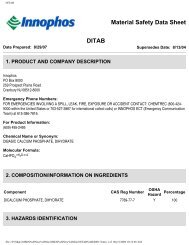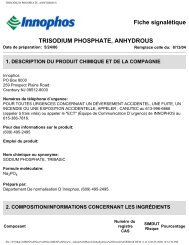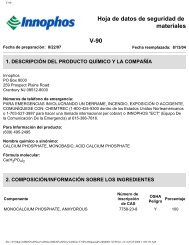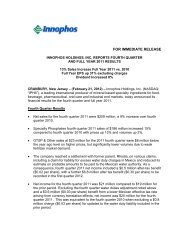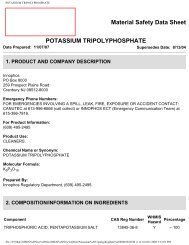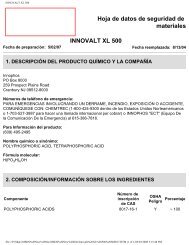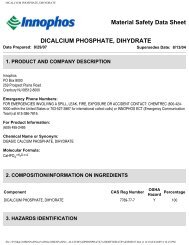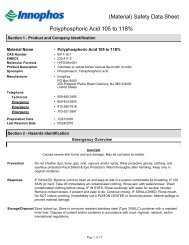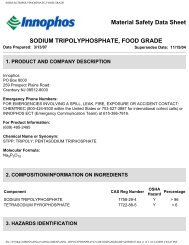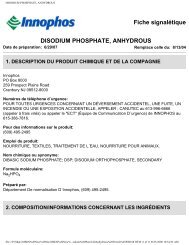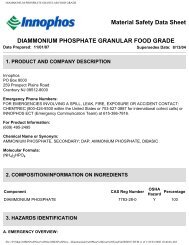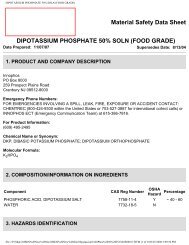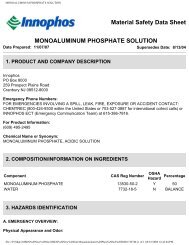V-90 (151.76 KB) - Innophos
V-90 (151.76 KB) - Innophos
V-90 (151.76 KB) - Innophos
You also want an ePaper? Increase the reach of your titles
YUMPU automatically turns print PDFs into web optimized ePapers that Google loves.
(Material) Safety Data SheetMonocalcium Phosphate, AnhydrousSection 1 - Product and Company IdentificationMaterial Name▪ Monocalcium Phosphate, AnhydrousCAS Number ▪ 7758-23-8Chemical Category▪ Particulates not otherwise classified (PNOC)EINECS ▪ 231-837-1Molecular Formula▪ Ca(H2PO4)2Molecular Weight ▪ 234Synonyms▪ Acid Calcium Phosphate; Calcium Phosphate, MonobasicManufacturerTelephoneTechnical ▪ 609-495-2495EmergencyEmergencyEmergency▪ <strong>Innophos</strong>PO Box 8000259 Prospect Plains Road Cranbury, NJ 08512-8000United States▪ 800-424-9300 - ChemtrecPreparation Date ▪ 08/13/2004Last Revision Date ▪ 09/20/2010▪ 615-386-7816 - <strong>Innophos</strong> Emergency Communication Team (ECT)▪ 703-527-3887 - Chemtrec - International Collect CallsSection 2 - Hazards IdentificationEmergency OverviewPreventionDo not breathe dusts or mists.Storage/Disposal Dispose of content and/or container in accordance with local, regional, national, and/or internationalregulations.OSHAWHMISEUGHSBased on currently available data, this product does not meet the regulatory definition of a hazardous substance.However, good industrial hygiene practices should be used in handling it.Route Of EntryMedical ConditionsAggravated by Exposure▪ None▪ None▪ None▪ None▪ Inhalation, Ingestion▪ Disorders of the lungs, SkinPage 1 of 11
NFPA:Potential Health EffectsInhalationAcute (Immediate)Chronic (Delayed)SkinAcute (Immediate)Chronic (Delayed)EyeAcute (Immediate)Chronic (Delayed)IngestionAcute (Immediate)Chronic (Delayed)Carcinogenic EffectsPotential EnvironmentalEffects▪ Exposure to dust may cause irritation. Nuisance dust may affect the lungs butreactions are typically reversible.▪ No data available▪ Exposure to dust may cause mechanical irritation.▪ No data available.▪ Exposure to dust may cause mechanical irritation. Can cause corneal scratch, eyeinjury which may persist for several days.▪ No data available.▪ Ingestion of large quantities may cause nausea, vomiting, diarrhea and abdominalcramps.▪ No data available.▪ This product does not contain any ingredient designated by IARC, NTP, ACGIH orOSHA as probable or suspected human carcinogens.▪ No data available.Section 3 - Composition/Information on IngredientsNon-HazardousComponentsChemical Name CAS %(weight) UN;EINECS LD50/LC50Phosphoric acid,calcium salt (2:1)7758-23-8 100% 231-837-1Ingestion/Oral-Rat LD50: =3986 mg/kgSkin-Rabbit LD50: >2 g/kgEUClassification &R PhrasesNDAOtherNDAThis product is not considered hazardous under the U.S. OSHA 29 CFR 1910.1200 Hazard Communication Standard. InCanada, the product mentioned above is not considered hazardous under the Workplace Hazardous Materials InformationSystem (WHMIS) This product is not considered dangerous under the European Directive 67/548/EEC According toRegulation (EC) No. 1272/2008 (CLP) this material is not considered hazardous. According to the Globally HarmonizedStandard for Classification and Labeling (GHS) this product is not considered hazardous.Section 4 - First Aid MeasuresInhalationSkin▪ If signs/symptoms develop, move person to fresh air. If signs/symptoms continue, getmedical attention.▪ IF ON SKIN: Wash with plenty of soap and water. If irritation develops and persists,get medical attention. Take off contaminated clothing and wash before reuse.Page 2 of 11
EyeIngestionNotes to PhysicianOther Information▪ In case of contact with substance, immediately flush eyes with running water for atleast 20 minutes. Seek immediate medical attention.▪ Do not induce vomiting unless instructed to do so by a physician. If victim isconscious and alert, give 2-3 glasses of water to drink. Seek immediate medicalattention. Do not leave victim unattended. To prevent aspiration of swallowed product,lay victim on side with head lower than waist. Vomiting may occur spontaneously. Ifvomiting occurs and the victim is conscious, give water to further dilute the chemical.▪ All treatments should be based on observed signs and symptoms of distress in thepatient. Consideration should be given to the possibility that overexposure to materialsother than this product may have occurred.▪ Call 911 or emergency medical service. Ensure that medical personnel are aware ofthe material(s) involved and take precautions to protect themselves.Section 5 - Fire Fighting MeasuresExtinguishing MediaUnsuitable ExtinguishingMediaFirefighting ProceduresUnusual Fire and ExplosionHazardsHazardous CombustionProductsProtection of Firefighters▪ Not combustible. Use extinguishing media suitable for surrounding fire.▪ None known.▪ Keep unauthorized personnel away.▪ Non-combustible.▪ None known.▪ Wear positive pressure self-contained breathing apparatus (SCBA). Structuralfirefighters' protective clothing will only provide limited protection.Section 6 - Accidental Release MeasuresPersonal PrecautionsEmergency ProceduresEnvironmental PrecautionsContainment/Clean-upMeasuresProhibited Materials▪ Do not touch or walk through spilled material.▪ Keep unauthorized personnel away. Wear appropriate protective gear.▪ Spills may be reportable to the National Response Center (800-424-8802) and to stateand/or local agencies.▪ Sweep or vacuum up and place in an appropriate closed container.Avoid generating dust. Clean up residual material by washing area with water anddetergent. Collect washings for disposal. Do not return material to its originalcontainer.▪ None known.Section 7 - Handling and StorageHandling▪ This is a food ingredient intended for human consumption. Keep containers closedwhen not in use. Avoid breathing dust. Avoid direct or prolonged contact with skin andeyes.Storage▪ Store in closed containers. Store in an area that is cool, dry, sanitary, well-ventilated,isolated from all toxic and harmful substances. This product is hygroscopic and tendsto cake on storage. Expected shelf life if stored at recommeneded temperatires: 12months.Special Packaging Materials ▪ None known.Incompatible Materials or ▪ No data availableIgnition SourcesSection 8 - Exposure Controls/Personal ProtectionPersonal Protective EquipmentPage 3 of 11
Pictograms▪RespiratoryEye/FaceHandsSkin/BodyGeneral Industrial HygieneConsiderationsEngineeringMeasures/Controls▪ For limited exposure use an N95 dust mask. For prolonged exposure use an airpurifyingrespirator with high efficiency particulate air (HEPA) filters. Follow the OSHArespirator regulations found in 29 CFR 1910.134 or European Standard EN 149. Use aNIOSH/MSHA or European Standard EN 149 approved respirator if exposure limits areexceeded or symptoms are experienced.▪ Wear eye protection.▪ Wear appropriate gloves.▪ Wear long sleeves and/or protective coveralls.▪ Wash hands before eating.▪ Dilution ventilation. Adequate ventilation systems as needed to control concentrationsof airborne contaminants below applicable threshold limit values.Exposure Limits/GuidelinesResult ACGIH Argentina Canada Ontario Canada Quebec ChinaSTELs Not established Not established Not established Not established16 mg/m3 STEL (freeSiO2 10%,total)as Particulates nototherwise classified(PNOC)MonocalciumPhosphate,AnhydrousTWAs10 mg/m3 TWA(inhalable particles,recommended); 3mg/m3 TWA(respirable particles,recommended)as Particulates nototherwise classified(PNOC)10 mg/m3 TWA(inhalable fraction,particulate mattercontaining noasbestos and lessthan 1% crystallinesilica); 3 mg/m3 TWA(respirable fraction,particulate mattercontaining noasbestos and lessthan 1% crystallinesilica)as Particulates nototherwise classified(PNOC)10 mg/m3 TWAEV(inhalableparticulate); 3 mg/m3TWAEV (respirableparticulate)as Particulates nototherwise classified(PNOC)10 mg/m3 TWAEV(total dust, containingno asbestos and lessthan 1% crystallinesilica)as Particulates nototherwise classified(PNOC)8 mg/m3 TWA (freeSiO2 10%,total)as Particulates nototherwise classified(PNOC)MonocalciumPhosphate,AnhydrousExposure Limits/Guidelines (Con't.)Result Malaysia New Zealand OSHA SingaporeTWAs10 mg/m3 TWA(particulate mattercontaining noasbestos and
espirable fraction)(PNOC)(PNOC)as Particulates nototherwise classified(PNOC)Key to abbreviationsTime-Weighted Averages are based on 8h/day,MSHA = Mine Safety and Health Administration TWA =40h/week exposuresPELPermissible Exposure Level determined by the Occupational Safety and=Health Administration (OSHA)American Conference of Governmental IndustrialACGIH =HygieneNational Institute of Occupational Safety andSTEL = Short Term Exposure Limits are based on 15-minute exposures NIOSH =HealthTWAEV = Time-Weighted Average Exposure ValueOSHA = Occupational Safety and Health AdministrationSection 9 - Physical and Chemical PropertiesPhysical FormAppearance/DescriptionColor : WhiteTaste : NDA▪ Solid▪ White powder with no odor.Odor : OdorlessOdor Threshold : NDABoiling Point: NDA Vapor Pressure: NDAMelting Point: NDA Vapor Density: NDASpecific Gravity: 0.59 Evaporation Rate: NDADensity: 36.8336 lb(s)/ft³ VOC (Wt.): NDABulk Density: NDA VOC (Vol.): NDApH: 4.2 (@ 1 wt/wt%) Volatiles (Wt.): NDAWater Solubility: Slightly Soluble Volatiles (Vol.): NDASolvent Solubility: NDA Flash Point: NDAViscosity: NDA Flash Point Test Type: NDAHalf-Life: NDA UEL: NDAOctanol/Water Partitioncoefficient:Coefficient of water/oildistribution:NDA LEL: NDANDA Autoignition: NDABioaccumulation Factor: NDA Bioconcentration Factor: NDABiochemical OxygenDemand BOD/BOD5:NDAChemical OxygenDemand:Persistence: NDA Degradation: NDANDASection 10 - Stability and ReactivityStabilityHazardous PolymerizationConditions to AvoidIncompatible MaterialsHazardous DecompositionProducts▪ Stable under normal temperatures and pressures.▪ Hazardous polymerization will not occur.▪ Dusting conditions. Heat extreme humidity.▪ None known.▪ None known.Section 11 - Toxicological InformationPage 5 of 11
Monocalcium Phosphate, Anhydrous 7758-23-8Test Type Dosage Units Route Species Duration Results Test ClassTargetOrgansAcute Toxicity 3986 mg/kg Ingestion/Oral Rat NDA LD50 NDA NDA NDAAcute Toxicity > 2 g/kg Skin Rabbit NDA LD50 NDA NDA NDAIrritation Eye Rabbit NDA NDAIrritation Skin Rabbit NDA NDAKey to abbreviationsLD= Lethal DoseSevere irritation,reversibleEssentially nonirritatingNDANDACommentsWashedAt 4 hoursSection 12 - Ecological InformationEcological FatePersistence/DegradabilityBioaccumulation PotentialMobility in Soil▪ No data found for product.▪ No data found for product.▪ No data found for product.▪ No data found for product.Section 13 - Disposal ConsiderationsProduct▪ Dispose of content and/or container in accordance with local, regional, national, and/orinternational regulations.Section 14 - Transportation InformationThe listed Transportation Classification does not address regulatory variations due to changes in package size, mode ofshipment or other regulatory descriptors.DOT - United States - Department of TransportationShipping Name: Not RegulatedTDG - Canada - Transport of Dangerous GoodsShipping Name: Not RegulatedIMO/IMDG –International Maritime TransportShipping Name: Not RegulatedADN - Europe Transport of Dangerous Goods by Road/Inland WaterwayShipping Name: Not RegulatedIATA - International Air Transport AssociationShipping Name: Not RegulatedADR - Europe Transport of Dangerous Goods by Road/Inland WaterwayShipping Name: Not RegulatedRID - Europe Transport of Dangerous Goods by RailwaysPage 6 of 11
Shipping Name: Not RegulatedSection 15 - Regulatory InformationSARA Hazard Classifications ▪ NoneRisk & Safety Phrases ▪ None.InventoryComponent CAS Australia AICS Canada DSL Canada NDSL China EU EINECSPhosphoric acid,calcium salt (2:1)7758-23-8 Yes Yes No Yes YesInventory (Con't.)Component CAS EU ELNICS Japan ENCS Korea KECL New Zealand Philippines PICCSPhosphoric acid,calcium salt (2:1)7758-23-8 No Yes Yes Yes YesInventory (Con't.)Component CAS Switzerland SWISS TSCAPhosphoric acid,calcium salt (2:1)7758-23-8 No YesCanadaLaborCanada - WHMIS - Classifications of Substances● Monocalcium Phosphate, Anhydrous 7758-23-8 Not ListedCanada - WHMIS - Ingredient Disclosure List● Monocalcium Phosphate, Anhydrous 7758-23-8 Not ListedEnvironmentCanada - CEPA - Priority Substances List● Monocalcium Phosphate, Anhydrous 7758-23-8 Not ListedChinaOtherChina - Annex I & II - Controlled Chemicals Lists● Monocalcium Phosphate, Anhydrous 7758-23-8 Not ListedChina - Dangerous Goods List● Monocalcium Phosphate, Anhydrous 7758-23-8 Not ListedCroatiaEnvironmentCroatia - Air Quality - Emission Limits for Stationary Sources● Monocalcium Phosphate, Anhydrous 7758-23-8 Not ListedCroatia - Air Quality - Limit Values for Gaseous Pollutants● Monocalcium Phosphate, Anhydrous 7758-23-8 Not ListedCroatia - Air Quality - Recommended Values for Gaseous Pollutants● Monocalcium Phosphate, Anhydrous 7758-23-8 Not ListedPage 7 of 11
EuropeEnvironmentEU - Substances Depleting the Ozone layer (1005/2009) - Annex I Substances● Monocalcium Phosphate, Anhydrous 7758-23-8 Not ListedEU - Seveso II Directive (96/82/EC) - Qualifying Quantities for Major Accident Notification● Monocalcium Phosphate, Anhydrous 7758-23-8 Not ListedEU - Seveso II Directive (96/82/EC) - Qualifying Quantities for Safety Report Requirements● Monocalcium Phosphate, Anhydrous 7758-23-8 Not ListedOtherEU - CLP (1272/2008) - Annex VI - Table 3.2 - Classification● Monocalcium Phosphate, Anhydrous 7758-23-8 Not ListedEU - CLP (1272/2008) - Annex VI - Table 3.2 - Concentration Limits● Monocalcium Phosphate, Anhydrous 7758-23-8 Not ListedEU - CLP (1272/2008) - Annex VI - Table 3.2 - Labelling● Monocalcium Phosphate, Anhydrous 7758-23-8 Not ListedEU - CLP (1272/2008) - Annex VI - Table 3.2 - Notes - Substances and Preparations● Monocalcium Phosphate, Anhydrous 7758-23-8 Not ListedEU - CLP (1272/2008) - Annex VI - Table 3.2 - Safety Phrases● Monocalcium Phosphate, Anhydrous 7758-23-8 Not ListedEU - Hazardous Substances Restricted or Prohibited in Electrical Equipment (2002/95/EC) (RoHS)● Monocalcium Phosphate, Anhydrous 7758-23-8 Not ListedIndiaEnvironmentIndia - Hazardous Chemical Rules - List of Hazardous and Toxic Chemicals● Monocalcium Phosphate, Anhydrous 7758-23-8 Not ListedIndia - Ozone Depleting Substances - Schedule I● Monocalcium Phosphate, Anhydrous 7758-23-8 Not ListedIndonesiaEnvironmentIndonesia - Hazardous Waste from Non-Specific Sources● Monocalcium Phosphate, Anhydrous 7758-23-8 Not ListedIndonesia - Hazardous Waste from Specific Sources● Monocalcium Phosphate, Anhydrous 7758-23-8 Not ListedJapanLaborJapan - ISHL Dangerous Substances● Monocalcium Phosphate, Anhydrous 7758-23-8 Not ListedPage 8 of 11
Japan - ISHL Designated Carcinogens● Monocalcium Phosphate, Anhydrous 7758-23-8 Not ListedJapan - ISHL Harmful Substances Prohibited for Manufacture● Monocalcium Phosphate, Anhydrous 7758-23-8 Not ListedEnvironmentJapan - Air Pollution Control Law - Emission Standards for Air Pollutants● Monocalcium Phosphate, Anhydrous 7758-23-8 Not ListedInventory - Japan - Industrial Safety and Health Law Substances (ISHL)● Monocalcium Phosphate, Anhydrous 7758-23-8 Not ListedKoreaLaborKorea - MOE - Harmful Substances● Monocalcium Phosphate, Anhydrous 7758-23-8 Not ListedKorea - ISHA - Name, Toxicity and Protective Measures of New Chemical Substances● Monocalcium Phosphate, Anhydrous 7758-23-8 Not ListedEnvironmentKorea - MOE - Toxic Chemicals Control Act (TCCA) - Observational Chemicals● Monocalcium Phosphate, Anhydrous 7758-23-8 Not ListedMalaysiaLaborMalaysia - Occupational Safety & Health - Risk Phrases● Monocalcium Phosphate, Anhydrous 7758-23-8 Not ListedMalaysia - Occupational Safety & Health - Safety Phrases● Monocalcium Phosphate, Anhydrous 7758-23-8 Not ListedEnvironmentMalaysia - Clean Air Regulations - Noxious and Offensive Substances● Monocalcium Phosphate, Anhydrous 7758-23-8 Not ListedMexicoEnvironmentMexico - Pollutant Release and Transfer Register - Reporting Emissions - Threshold Quantities● Monocalcium Phosphate, Anhydrous 7758-23-8 Not ListedOtherMexico - Hazard Classifications● Monocalcium Phosphate, Anhydrous 7758-23-8 Not ListedMexico - Regulated Substances● Monocalcium Phosphate, Anhydrous 7758-23-8 Not ListedPhilippinesPage 9 of 11
OtherPhilippines - Priority Chemical List● Monocalcium Phosphate, Anhydrous 7758-23-8 Not ListedSingaporeEnvironmentSingapore - Air Impurities Emission Limits● Monocalcium Phosphate, Anhydrous 7758-23-8 Not ListedSingapore - List of Hazardous Substances● Monocalcium Phosphate, Anhydrous 7758-23-8 Not ListedSouth AfricaLaborSouth Africa - General Machinery Regulations - Notifiable Substances● Monocalcium Phosphate, Anhydrous 7758-23-8 Not ListedTaiwanEnvironmentTaiwan - Toxic Chemical Substances Control Act - Threshold Regulated Quantities● Monocalcium Phosphate, Anhydrous 7758-23-8 Not ListedTaiwan - Toxic Chemical Substances Control Act - Classification and Control Levels● Monocalcium Phosphate, Anhydrous 7758-23-8 Not ListedThailandLaborThailand - Air Contaminant Standards● Monocalcium Phosphate, Anhydrous 7758-23-8 Not ListedEnvironmentThailand - Quantities of Chemicals● Monocalcium Phosphate, Anhydrous 7758-23-8 Not ListedOtherThailand - Hazardous Substances● Monocalcium Phosphate, Anhydrous 7758-23-8 Not ListedUnited StatesEnvironmentU.S. - CAA (Clean Air Act) - 19<strong>90</strong> Hazardous Air Pollutants● Monocalcium Phosphate, Anhydrous 7758-23-8 Not ListedU.S. - CAA (Clean Air Act) - Class I Ozone Depletors● Monocalcium Phosphate, Anhydrous 7758-23-8 Not ListedU.S. - CAA (Clean Air Act) - Class II Ozone Depletors● Monocalcium Phosphate, Anhydrous 7758-23-8 Not ListedU.S. - CERCLA/SARA - Hazardous Substances and their Reportable QuantitiesPage 10 of 11
● Monocalcium Phosphate, Anhydrous 7758-23-8 Not ListedU.S. - CERCLA/SARA - Section 302 Extremely Hazardous Substances EPCRA RQs● Monocalcium Phosphate, Anhydrous 7758-23-8 Not ListedU.S. - CERCLA/SARA - Section 302 Extremely Hazardous Substances TPQs● Monocalcium Phosphate, Anhydrous 7758-23-8 Not ListedU.S. - CERCLA/SARA - Section 313 - PBT Chemical Listing● Monocalcium Phosphate, Anhydrous 7758-23-8 Not ListedU.S. - RCRA (Resource Conservation & Recovery Act) - List for Hazardous Constituents● Monocalcium Phosphate, Anhydrous 7758-23-8 Not ListedU.S. - SDWA (Safe Drinking Water Act) - CCL (Contaminant Candidate List)● Monocalcium Phosphate, Anhydrous 7758-23-8 Not ListedVietnamEnvironmentVietnam - Air Quality - Ambient Air Quality Standards● Monocalcium Phosphate, Anhydrous 7758-23-8 Not ListedVietnam - Air Quality - Industrial Emission Standards● Monocalcium Phosphate, Anhydrous 7758-23-8 Not ListedVietnam - Air Quality - Maximum Allowable Concentration of Highly Hazardous Chemicals● Monocalcium Phosphate, Anhydrous 7758-23-8 Not ListedOther Information ▪ FDA Status: This product meets the compositional requirements of: 21 CFR 182.1217CALCIUM PHOSPHATESection 16 - Other InformationPreparation Date ▪ 08/13/2004Last Revision Date ▪ 09/20/2010Disclaimer/Statement ofLiability▪ The information herein is given in good faith but no warranty, expressed or implied, ismade.Key to abbreviationsNDA = No Data AvailablePage 11 of 11



